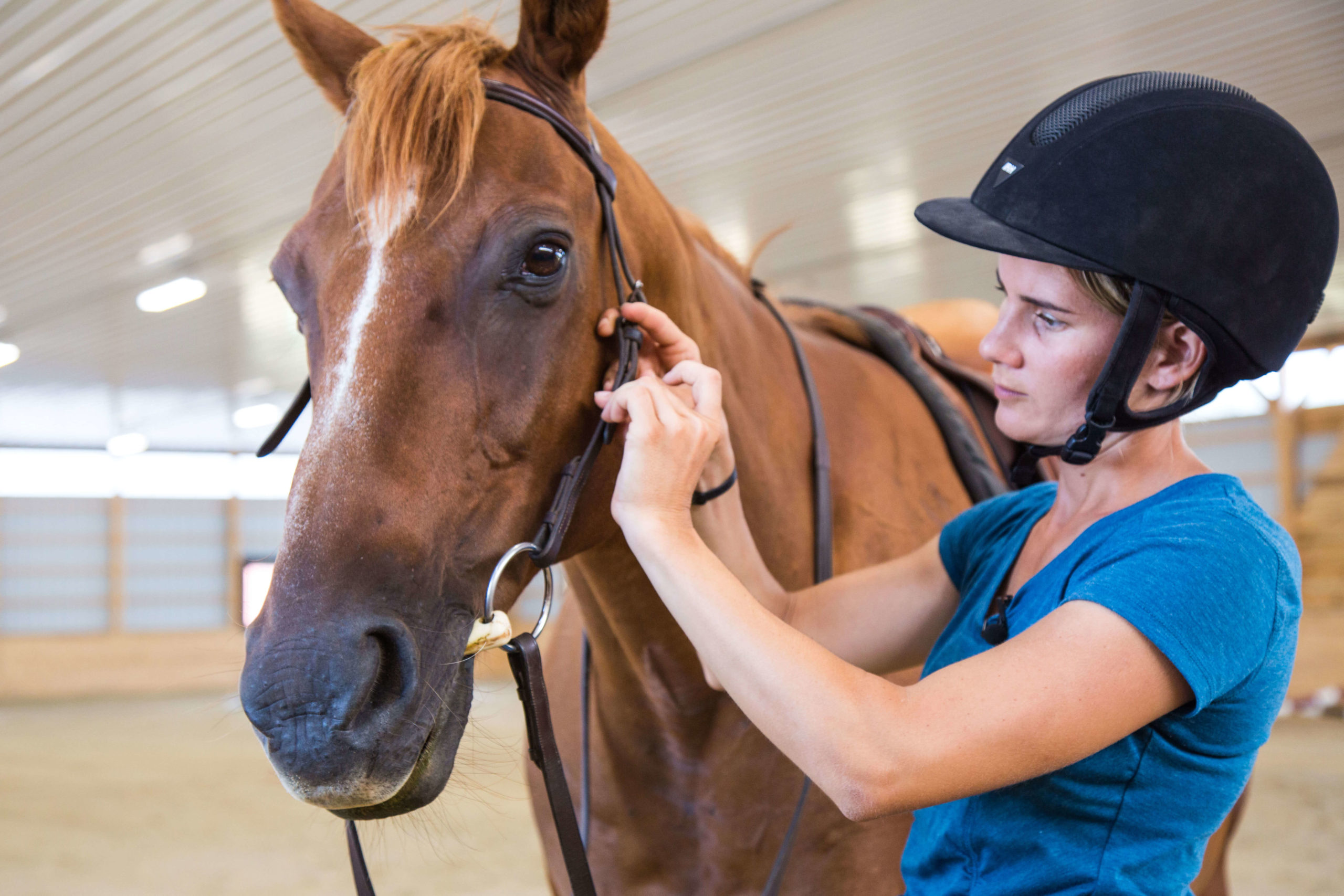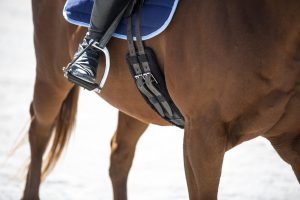In caring for a horse, there is a lot we do around their head. We need to be able to slip on a halter or bridle, give dewormers and other oral medications, or trim the hair around ears, muzzle, and bridle path.
When a horse is “head shy”, they may resist any form of handling around their head, or they may develop a specific aversion, such as to touching their lips or ears.
The horse may learn many moves to get away from what is for them an unpleasant experience, they may lift their head, toss their head, run backwards, push forwards, or break lead ropes or cross ties. Any of these behaviors can be dangerous for both horse and handler, plus the more often they occur, the stronger the head shy behavior will become.
Fortunately, you can teach your horse to accept touching around their head, and work through any specific aversions they may have, but it can take time and patience. How long retraining takes depends on what started the behavior and how long the horse has been effectively avoiding the bridle, bit, dewormer tube, etc.

Why Horses Become Head Shy
There are two main causes of head shy behavior.
- The horse has not been handled. The head is a sensitive area, the horse naturally wants to protect his head and if he has not experienced all the sensations of straps slipping over his ears, his mouth being opened, or a hand touching the delicate area of the eye, he will naturally be wary.
- The horse has had a bad experience. When pain or fear are involved learning only takes one repetition. If a bit is clanked against teeth, a clipper pinches or burns the skin, or the horse is hit around the head with a hand or whip, they can very quickly become head shy.
A horse that has had bad experiences will often take a bit longer to change head shy behavior then one who simply has a lack of handling.
Let’s take a look at how we can change head shy behavior. But first, I’d like to explain two important ways that the horse learns.
How Horses Learn
The first is associative learning. Here the horse connects his actions to outcomes, and then will change his behavior to create more pleasant outcomes. What’s referred to in behavior as “reinforcements” will cause the horse to do more of a particular behavior, while “punishments” will cause him to do less of that behavior. When working with a head shy horse, I use two forms of reinforcement – giving a reward (positive reinforcement) and releasing pressure (negative reinforcement) for the correct response, which for most head shy horses is standing still or lowering their head.
The second way in which horses learn that is important for understanding head shy behavior is non-associative learning. This is where the horse becomes de-sensitized to things or experiences that don’t create any unpleasant outcomes and sensitized to ones that do.
Here’s how these learning concepts apply to our head shy horse:
The handler lifts the halter to slip it over the horse’s ears, the horse doesn’t like the feeling, whether from a previous bad experience or simply because it isn’t familiar. The horse lifts his head away from the handler and the bridle drops back down away from his ears. The horse has just been reinforced for the head shy behavior because he got away from the feeling of the bridle. Next time, he will likely try lifting his head higher and more quickly.
However, the outcome will be different if the next time, the handler keeps the halter against the ear even when the horse lifts his head and then gives him a small reward when he drops it back down. Now the behavior of lowering the head has been reinforced. Also, since the horse experienced no pain while having his ear touched, he has begun to desensitize, or get used to, that feeling.
Changing Your Horse’s Behavior
Here are a few questions to ask yourself as you consider your own horse’s behavior:
- Could there be a physical cause? If something is causing your horse discomfort, he will continue to try and escape the pain. Examples of problems that can cause head shyness would be warts or other growths on the ear, sharp points on teeth, or ulcers on lips or in the mouth.
- How can you break the problem down? If raising the head when bridling is the problem, then beginning with teaching head down is the best start. If giving a dewormer is the problem, then touching the lips with both your hands and the syringe is a good start. If it is difficult to even get close to your horse’s head, then touching their neck is a good place to begin.
- How can you reinforce the correct behavior? There are two ways to reinforce a behavior and tell the horse that “what he just did was right”. The first is to release pressure, meaning move your hand away, turn off the clippers, remove the syringe, etc. The second is to give a reward. Rewards also have the powerful effect of beginning the process of what is called “counter-conditioning”. This means that by pairing something good (a food reward) with something the horse didn’t like (being touched around his head), his association of being touched changes from feeling it as aversive to connecting it to the good event of being fed.
4. Set your horse and yourself up for success. Begin working on a problem such as head shy behavior in a place where there are not many distractions and your horse is comfortable.
Also, by breaking down the problem (#2 above) you are more likely to find success in each small step. Ask for what you are confident you can do, for example, touching the ears of a horse who doesn’t want his ears clipped with just your hand, before working up to touching the ear with clippers running, then holding clippers against the ear, then clipping, etc.
Think of a problem such as head shy behavior as an opportunity to spend time teaching your horse something new and improving your relationship.
As with any behavior problem, the path to success is to break the problem down, set your horse up for success by going slow and creating little wins, and be willing to change your approach when things aren’t working.
As George Poyla said, “If you can’t solve a problem, then there is an easier problem you can solve. Find it.”














3 Responses
This week’s video is so timely — was just wondering how to deal with a horse that gets extremely impatient (or at least I think that’s the situation) and throws his head up and down while I’m attempting to attach the cross ties. He’s fine when being bridled. But after a riding session is done he seems most anxious to get back out with his buddies, so, for example, today he did a lot of head bobbing make it almost impossible to clip the cross ties. Eventually I did. And that was followed up by pawing the ground. Next time should I do what you modeled in the video?
Thanks for all the great info and insights that you share with us.
Yes, I would teach him head down and still as this will allow you to clip on the crossties. I would teach it in a different setting however, not in this situation after a ride where he is already upset. Teach it in a relaxed setting and then apply it here in this more difficult one.
It won’t stop the other behaviors but will make attaching the crossties easier. Working on the other frustration behaviors would involve teaching him to stand still for very short periods and gradually making that still time longer.
Dear Callie,
Very good lesson Callie….
When I watch horses trot(not in pictures, not on tv) (not dressage)they look like their floating above the ground…so fluid….so much grace…such beauty(for 1200 lbs.) I can’t help but loving them.